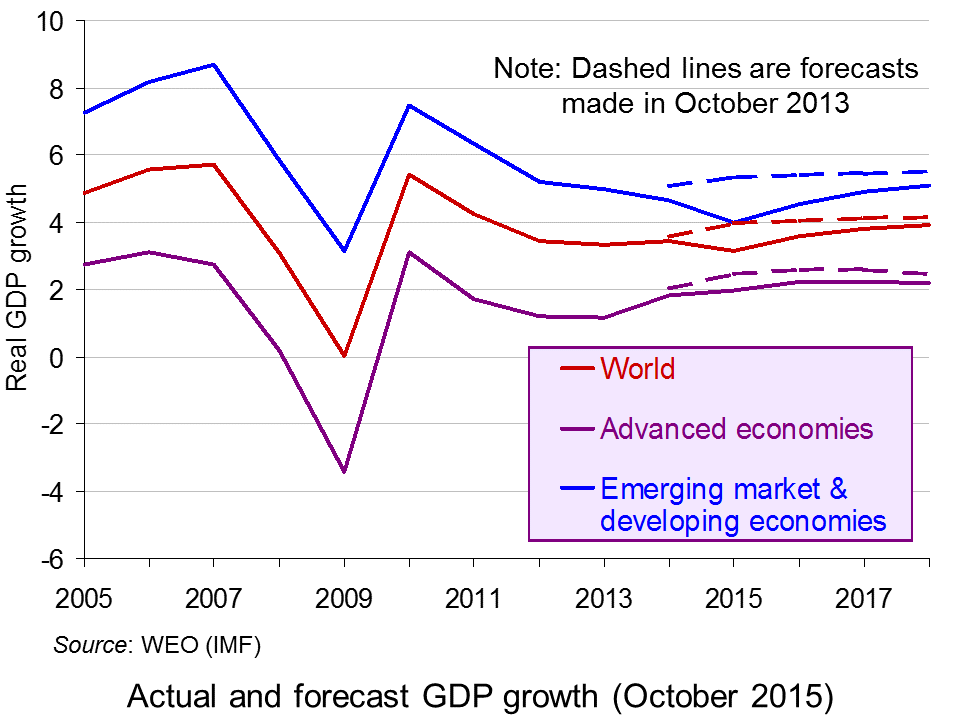 As we saw in several posts on this site, last year was a tumultuous one for the Greek people and their economy. The economy was on the verge of bankruptcy; the Greek people rejected the terms of a bailout in a referendum; exit from the eurozone and having to return to the drachma seemed likely; banks were forced to closed at the height of the crisis; capital controls were imposed, with people restricted to drawing €60 a day or €420 a week – a policy still in force today; unemployment soared and many people suffered severe hardship.
As we saw in several posts on this site, last year was a tumultuous one for the Greek people and their economy. The economy was on the verge of bankruptcy; the Greek people rejected the terms of a bailout in a referendum; exit from the eurozone and having to return to the drachma seemed likely; banks were forced to closed at the height of the crisis; capital controls were imposed, with people restricted to drawing €60 a day or €420 a week – a policy still in force today; unemployment soared and many people suffered severe hardship.
To achieve the bailout, the Syriza government had to ignore the results of the referendum and agree to harsh austerity policies and sweeping market-orientated supply-side policies. This, at least, allowed Greece to stay in the eurozone. It held, and won, another election to seek a further mandate for these policies.
 But what are the prospects for 2016? Will it be a year of recovery and growth, with market forces working to increase productivity? Does 2016 mark the beginning of the end and, as prime minister Alexis Tsipras put it, “a final exit from economic crisis”?
But what are the prospects for 2016? Will it be a year of recovery and growth, with market forces working to increase productivity? Does 2016 mark the beginning of the end and, as prime minister Alexis Tsipras put it, “a final exit from economic crisis”?
Or will the continuing cuts simply push the economy deeper into recession, with further rises in unemployment and more and more cases of real human hardship? Is there a hysteresis effect here, with the past six years having created a demoralised and deskilled people, with cautious investors unable and/or unwilling to rebuild the economy?
 The article below looks at the rather gloomy prospects for Greece and at whether there are any encouraging signs. It also looks at the further demands of the troika of creditors – the IMF, the ECB and the European Commission’s European Stability Mechanism (ESM) – and at what the political and economic impact of these might be.
The article below looks at the rather gloomy prospects for Greece and at whether there are any encouraging signs. It also looks at the further demands of the troika of creditors – the IMF, the ECB and the European Commission’s European Stability Mechanism (ESM) – and at what the political and economic impact of these might be.
Greece’s economic crisis goes on, like an odyssey without end The Guardian, Helena Smith (4/1/16)
Questions
- Construct a timeline of Greece’s debt repayments, both past and scheduled, and of the bailouts given by the troika to prevent Greece defaulting.
- What supply-side reforms are being demanded by Greece’s creditors?
- What will be the effect of these supply-side reforms in (a) the short run; (b) the long run?
- Explain the meaning of hysteresis as it applies to an economy in the aftermath of a recession. How does the concept apply in the Greek situation?
- Discuss the alternative policy options open to the Greek government for tackling the persistent recession.
- Would it be better for Greece to leave the euro? Explain your arguments.
- “I cannot see how this government can survive the reforms. And I cannot see how it can avoid these reforms.” Is there any way out of this apparent impasse for the Greek government?
 The International Monetary Fund has just published its six-monthly World Economic Outlook (WEO). The publication assesses the state of the global economy and forecasts economic growth and other indicators over the next few years. So what is this latest edition predicting?
The International Monetary Fund has just published its six-monthly World Economic Outlook (WEO). The publication assesses the state of the global economy and forecasts economic growth and other indicators over the next few years. So what is this latest edition predicting?
Well, once again the IMF had to adjust its global economic growth forecasts down from those made six months ago, which in turn were lower than those made a year ago. As Larry Elliott comments in the Guardian article linked below:
Every year, economists at the fund predict that recovery is about to move up a gear, and every year they are disappointed. The IMF has over-estimated global growth by one percentage point a year on average for the past four years.
In this latest edition, the IMF is predicting that growth in 2015 will be slightly higher in developed countries than in 2014 (2.0% compared with 1.8%), but will continue to slow for the fifth year in emerging market and developing countries (4.0% in 2015 compared with 4.6% in 2014 and 7.5% in 2010).
In an environment of declining commodity prices, reduced capital flows to emerging markets and pressure on their currencies, and increasing financial market volatility, downside risks to the outlook have risen, particularly for emerging market and developing economies.
So what is the cause of this sluggish growth in developed countries and lower growth in developing countries? Is lower long-term growth the new norm? Or is this a cyclical effect – albeit protracted – with the world economy set to resume its pre-financial-crisis growth rates eventually?
 To achieve faster economic growth in the longer term, potential national output must grow more rapidly. This can be achieved by a combination of more rapid technological progress and higher investment in both physical and human capital. But in the short term, aggregate demand must expand sufficiently rapidly. Higher short-term growth will encourage higher investment, which in turn will encourage faster growth in potential national output.
To achieve faster economic growth in the longer term, potential national output must grow more rapidly. This can be achieved by a combination of more rapid technological progress and higher investment in both physical and human capital. But in the short term, aggregate demand must expand sufficiently rapidly. Higher short-term growth will encourage higher investment, which in turn will encourage faster growth in potential national output.
But aggregate demand remains subdued. Many countries are battling to cut budget deficits, and lending to the private sector is being constrained by banks still seeking to repair their balance sheets. Slowing growth in China and other emerging economies is dampening demand for raw materials and this is impacting on primary exporting countries, which are faced with lower exports and lower commodity prices.
Quantitative easing and rock bottom interest rates have helped somewhat to offset these adverse effects on aggregate demand, but as the USA and UK come closer to raising interest rates, so this could dampen global demand further and cause capital to flow from developing countries to the USA in search of higher interest rates. This will put downward pressure on developing countries’ exchange rates, which, while making their exports more competitive, will make it harder for them to finance dollar-denominated debt.
As we have seen, long-term growth depends on growth in potential output, but productivity growth has been slower since the financial crisis. As the Foreword to the report states:
The ongoing experience of slow productivity growth suggests that long-run potential output growth may have fallen broadly across economies.  Persistently low investment helps explain limited labour productivity and wage gains, although the joint productivity of all factors of production, not just labour, has also been slow. Low aggregate demand is one factor that discourages investment, as the last World Economic Outlook report showed. Slow expected potential growth itself dampens aggregate demand, further limiting investment, in a vicious circle.
Persistently low investment helps explain limited labour productivity and wage gains, although the joint productivity of all factors of production, not just labour, has also been slow. Low aggregate demand is one factor that discourages investment, as the last World Economic Outlook report showed. Slow expected potential growth itself dampens aggregate demand, further limiting investment, in a vicious circle.
But is this lower growth in potential output entirely the result of lower demand? And will the effect be permanent? Is it a form of hysteresis, with the effect persisting even when the initial causes have disappeared? Or will advances in technology, especially in the fields of robotics, nanotechnology and bioengineering, allow potential growth to resume once confidence returns?
Which brings us back to the short and medium terms. What can be done by governments to stimulate sustained recovery? The IMF proposes a focus on productive infrastructure investment, which will increase both aggregate demand and aggregate supply, and also structural reforms. At the same time, loose monetary policy should continue for some time – certainly as long as the current era of falling commodity prices, low inflation and sluggish growth in demand persists.
Articles
Uncertainty, Complex Forces Weigh on Global Growth IMF Survey Magazine (6/10/15)
A worried IMF is starting to scratch its head The Guardian, Larry Elliott (6/10/15)
Storm clouds gather over global economy as world struggles to shake off crisis The Telegraph, Szu Ping Chan (6/10/15)
Five charts that explain what’s going on in a miserable global economy right now The Telegraph, Mehreen Khan (6/10/15)
IMF warns on worst global growth since financial crisis Financial Times, Chris Giles (6/10/15)
Global economic slowdown in six steps Financial Times, Chris Giles (6/10/15)
IMF Downgrades Global Economic Outlook Again Wall Street Journal, Ian Talley (6/10/15)
WEO publications
World Economic Outlook, October 2015: Adjusting to Lower Commodity Prices IMF (6/10/15)
 Global Growth Slows Further, IMF’s latest World Economic Outlook IMF Podcast, Maurice Obstfeld (6/10/15)
Global Growth Slows Further, IMF’s latest World Economic Outlook IMF Podcast, Maurice Obstfeld (6/10/15)
Transcript of the World Economic Outlook Press Conference IMF (6/10/15)
World Economic Outlook Database IMF (October 2015 edition)
Questions
- Look at the forecasts made in the WEO October editions of 2007, 2010 and 2012 for economic growth two years ahead and compare them with the actual growth experienced. How do you explain the differences?
- Why is forecasting even two years ahead fraught with difficulties?
- What factors would cause a rise in (a) potential output; (b) potential growth?
- What is the relationship between actual and potential economic growth?
- Explain what is meant by hysteresis. Why may recessions have a permanent negative effect, not only on trend productivity levels, but on trend productivity growth?
- What are the current downside risks to the global economy?
- Why have commodity prices fallen? Who gains and who loses from lower commodity prices? Does it matter if falling commodity prices in commodity importing countries result in negative inflation?
- To what extent can exchange rate depreciation help commodity exporting countries?
- What is meant by the output gap? How have IMF estimates of the size of the output gap changed and what is the implication of this for actual and potential economic growth?
Twice a year, directly after the government’s Spring Budget and Autumn Statement, the Institute for Fiscal Studies gives its verdict on the performance of the economy and the government’s economic policies – past and planned. This year is no exception. After the Chancellor had delivered his Autumn Statement, the next day the IFS published its analysis. And what grim reading it makes.
• Real average (mean) incomes in 2011 will have fallen by 3%.
• Between 2009/10 and 2012/13, real median household incomes will have fallen by 7.4%
• Over the same period, real mean household income will have fallen by 4.7% – easily the biggest 3-year drop since records began in the mid 1950s.
• Real mean household incomes will be no higher in 2015/16 than in 2002/03.
• The poorest will be hardest hit by the measures announced in the Autumn Statement.
• Infrastructure spending of £4bn to £5bn will only go some way offsetting the effects of £17bn capital spending cuts over the Parliament.
• The economy will be 3.5% smaller in 2016 than thought in March.
• The structural budget deficit is 1.6% higher than thought in March.
• That will extend to 6 years the period over which total spending will have been cut year on year.
Referring to this last point, Paul Johnson, director of the IFS, said in his Opening Remarks, “One begins to run out of superlatives for describing quite how unprecedented that is. Certainly there has been no period like it in the UK in the last 60 years.” Referring to the fall in real incomes, he said, “Again we are running out of superlatives to describe just how extraordinary are some of these changes.”
Commentators have referred to the “lost decade” where the average Briton will not have seen an increase in real income.
Articles
Autumn Statement 2011: Families face ‘lost decade’ as spending power suffers biggest fall since 1950s, says IFS The Telegraph, Matthew Holehouse (30/11/11)
Autumn Statement 2011: IFS talks down George Osborne’s growth plan The Telegraph, Philip Aldrick (30/11/11)
Autumn statement study by IFS predicts lost decade for UK living standards Guardian, Katie Allen and Larry Elliott (30/11/11)
Britons Enduring 13-Year Squeeze on Living Standards, IFS Says Bloomberg Businessweek, Gonzalo Vina (30/11/11)
The UK now faces a ‘lost decade’ Financial Times, Martin Wolf (29/11/11)
Warning of seven-year squeeze Independent, James Tapsfield, Andrew Woodcock (30/11/11)
Osborne’s impact laid bare: The rich get richer and the poor get poorer Independent, Ben Chu, Oliver Wright (1/12/11)
Incomes to fall 7.4% in three years, says IFS BBC News (30/11/11)
 No growth in income for 14 years, warns IFS BBC News, IFS director Paul Johnson (30/11/11)
No growth in income for 14 years, warns IFS BBC News, IFS director Paul Johnson (30/11/11)
 UK economy: Third worst year since the war BBC Today Programme, IFS director Paul Johnson (29/11/11)
UK economy: Third worst year since the war BBC Today Programme, IFS director Paul Johnson (29/11/11)
IFS Analysis
Autumn Statement 2011 and the OBR Economic and Fiscal Outlook IFS (30/11/11)
Questions
- Why is it likely that the median real income will have fallen by more than the mean real income?
- Why is the structural deficit now estimated to be some 1.6 percentage points higher than was estimated by the OBR back in March 2011?
- How could the structural deficit be affected by a prolonged recession? Is this a case of hysteresis?
- What are the government’s fiscal rules?
- Is the IFS predicting that the rules will be met? What might adversely affect this prediction?
- If technological progress is allowing a continuous increase in potential real GDP, why will median real incomes have fallen over the 13 years between 2002/03 and 2015/16? What might have affected long-term aggregate supply adversely?
The recession caused a large rise in unemployment in many countries. In the USA the rise has been particularly steep, where unemployment now stands at 14.5 million, or 9.8% of the labour force. Unemployment has continued to rise despite renewed growth in the US economy, where the latest annual real GDP growth is 2.6% (measured in Q3 2010). The rise in unemployment has been blamed on ‘sticky wages’ – i.e. the reluctance of wage rates to fall.
But are wages genuinely sticky as far as the average worker is concerned? They may be in many specific jobs with specific employers, but many workers made redundant then find work in different jobs at lower rates of pay. For them, their wage has fallen, even if particular jobs are paying the same as before.
So what are the consequences of this? Does the willingness of workers to accept lower paid jobs mean that the labour market is flexible and that people will thus price themselves into work? If so, why is employment still rising? Or does a reduction in real wages for many people dampen spending and hence aggregate demand, thereby reducing the demand for labour? If so, why is GDP rising?
The following articles look at the apparent stickiness of wages and the implications for the labour market and the macroeconomy.
Articles
Downturn’s Ugly Trademark: Steep, Lasting Drop in Wages Wall Street Journal, Sudeep Reddy (11/1/11)
The Causes of Unemployment Seeking Alpha, Brad DeLong (13/1/11)
Sticky, sticky wages The Economist blogs: Free Exchange, R.A. (11/1/11)
The Causes of Unemployment New York Times blogs: Wonkish, Paul Krugman (16/1/11)
America’s union-bashing backlash Guardian, Paul Harris (5/1/11)
Data
Federal Reserve Economic Data: FRED Federal Reserve Bank of St. Louis (US macroeconomic datasets)
United States GDP Growth Rate Trading Economics
US unemployment statistics Bureau of Labor Statistics
Questions
- Why might nominal wages be sticky downwards in specific jobs in specific companies?
- Why might nominal average wages in the economy not be sticky downwards?
- Why is unemployment rising in the USA?
- Why might there be a problem of hysteresis in the USA that provides an explanation of the reluctance of unemployment to fall?
- Why might a fall in wages end up being contractionary?
- What lessons can be learned from the Great Depression about cures for unemployment?
- How might unemployment be brought down in the USA?
- Why may making wages somewhat more flexible, as opposed to perfectly flexible, not be a good thing?
Until the credit crunch and crash of 2008/9, there appeared to be a degree of consensus amongst economists about how economies worked. Agents were generally assumed to be rational and markets generally worked to balance demand and supply at both a micro and a macro level. Although economies were subject to fluctuations associated with the business cycle, these had become relatively mild given the role of central banks in targeting inflation and the general belief that we had seen the end of boom and bust.
True, markets were not perfect. There were problems of monopoly power and externalities. Also information was not perfect. But asymmetries of information were generally felt to be relatively unimportant in the information age with easy access to market data through the internet.
Then it all went wrong. With the exception of a few economists, people were caught unawares by the credit crunch. There was too little understanding of the complexities of securitisation and the leveraged risk in these pyramids of debt built on small foundations. And there was too little regard paid to the potentially destructive power of speculation and herd behaviour.
So how should economists model what has been happening over the past three years? Do we simply need to go back to Keynesian economics, which emphasised the importance of aggregate demand and the ability of economies to settle at a high unemployment equilibrium? Can the persistence of high unemployment in the USA and elsewhere be put down to a lack of demand or is the explanation to be found in hysteresis: the persistence of a problem after the initial cause has disappeared? Can failures of markets be incorporated into standard microeconomics?
Or do we need a new paradigm: one that emphasises the behaviour of economic agents and examines how people act when there are information asymmetries? These are the questions that are examined in the podcast below. It is an interview with Nobel Prize winning economist, Joseph Stiglitz.
Podcast
 Joseph Stiglitz: ‘Building blocks’ of a new economics BBC Today Programme (25/8/10)
Joseph Stiglitz: ‘Building blocks’ of a new economics BBC Today Programme (25/8/10)
Articles
Needed: a new economic paradigm Financial Times, Joseph Stiglitz (19/8/10)
Obama should get rid of Geithner, Summers Market Watch, Wall Street Journal, Darrell Delamaide (25/8/10)
This rebel’s heresy is not so earth-shaking Fund Strategy, Daniel Ben-Ami (23/8/10)
Questions
- What are Stiglitz’s criticisms of the economics profession in recent years?
- What, according to Stiglitz, should be the features of a new economic paradigm?
- Is such a paradigm new?
- Provide a critique of Stiglitz’s analysis.
- What do you understand by ‘behavioural economics’? Would a greater understanding of human behaviour by economists have helped avert the credit crunch and subsequent recession?
 As we saw in several posts on this site, last year was a tumultuous one for the Greek people and their economy. The economy was on the verge of bankruptcy; the Greek people rejected the terms of a bailout in a referendum; exit from the eurozone and having to return to the drachma seemed likely; banks were forced to closed at the height of the crisis; capital controls were imposed, with people restricted to drawing €60 a day or €420 a week – a policy still in force today; unemployment soared and many people suffered severe hardship.
As we saw in several posts on this site, last year was a tumultuous one for the Greek people and their economy. The economy was on the verge of bankruptcy; the Greek people rejected the terms of a bailout in a referendum; exit from the eurozone and having to return to the drachma seemed likely; banks were forced to closed at the height of the crisis; capital controls were imposed, with people restricted to drawing €60 a day or €420 a week – a policy still in force today; unemployment soared and many people suffered severe hardship. But what are the prospects for 2016? Will it be a year of recovery and growth, with market forces working to increase productivity? Does 2016 mark the beginning of the end and, as prime minister Alexis Tsipras put it, “a final exit from economic crisis”?
But what are the prospects for 2016? Will it be a year of recovery and growth, with market forces working to increase productivity? Does 2016 mark the beginning of the end and, as prime minister Alexis Tsipras put it, “a final exit from economic crisis”? The article below looks at the rather gloomy prospects for Greece and at whether there are any encouraging signs. It also looks at the further demands of the troika of creditors – the IMF, the ECB and the European Commission’s European Stability Mechanism (ESM) – and at what the political and economic impact of these might be.
The article below looks at the rather gloomy prospects for Greece and at whether there are any encouraging signs. It also looks at the further demands of the troika of creditors – the IMF, the ECB and the European Commission’s European Stability Mechanism (ESM) – and at what the political and economic impact of these might be.


